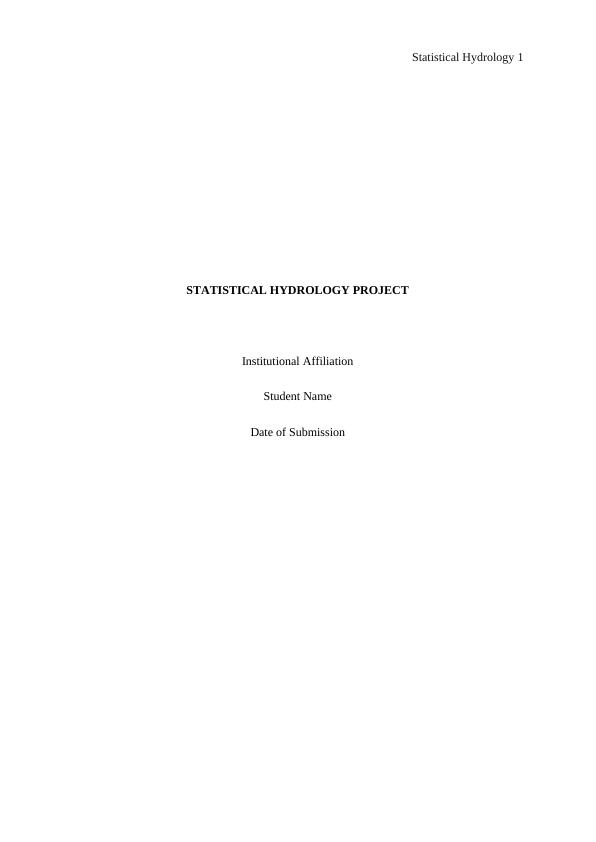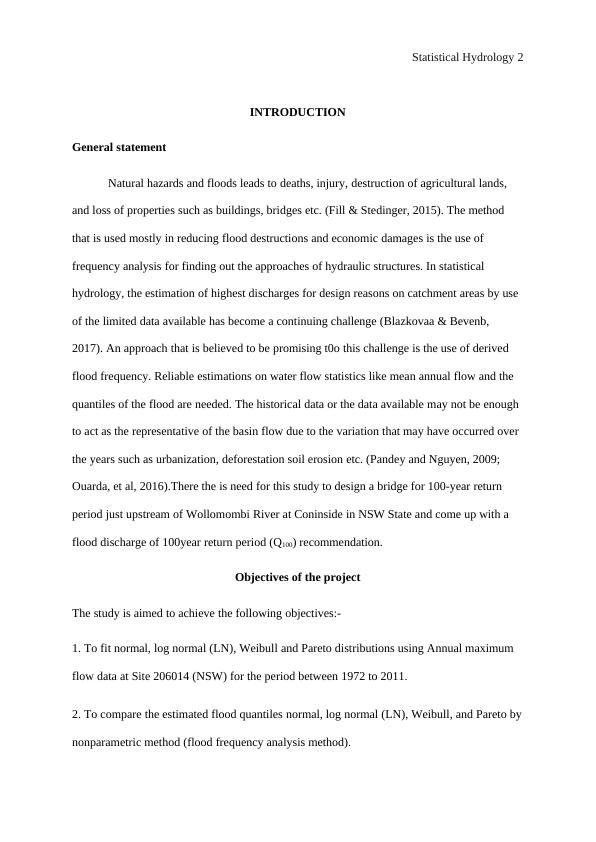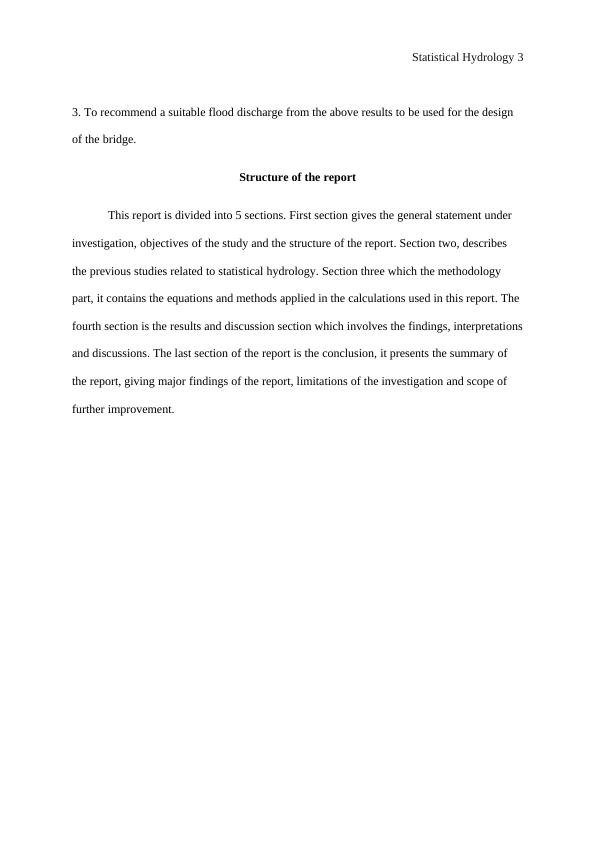Statistical Hydrology | Assessment - 1
Carry out statistical analysis on annual maximum flow data for flood estimation and prepare a project report.
20 Pages3102 Words141 Views
Added on 2022-10-08
Statistical Hydrology | Assessment - 1
Carry out statistical analysis on annual maximum flow data for flood estimation and prepare a project report.
Added on 2022-10-08
ShareRelated Documents
Statistical Hydrology 1
STATISTICAL HYDROLOGY PROJECT
Institutional Affiliation
Student Name
Date of Submission
STATISTICAL HYDROLOGY PROJECT
Institutional Affiliation
Student Name
Date of Submission

Statistical Hydrology 2
INTRODUCTION
General statement
Natural hazards and floods leads to deaths, injury, destruction of agricultural lands,
and loss of properties such as buildings, bridges etc. (Fill & Stedinger, 2015). The method
that is used mostly in reducing flood destructions and economic damages is the use of
frequency analysis for finding out the approaches of hydraulic structures. In statistical
hydrology, the estimation of highest discharges for design reasons on catchment areas by use
of the limited data available has become a continuing challenge (Blazkovaa & Bevenb,
2017). An approach that is believed to be promising t0o this challenge is the use of derived
flood frequency. Reliable estimations on water flow statistics like mean annual flow and the
quantiles of the flood are needed. The historical data or the data available may not be enough
to act as the representative of the basin flow due to the variation that may have occurred over
the years such as urbanization, deforestation soil erosion etc. (Pandey and Nguyen, 2009;
Ouarda, et al, 2016).There the is need for this study to design a bridge for 100-year return
period just upstream of Wollomombi River at Coninside in NSW State and come up with a
flood discharge of 100year return period (Q100) recommendation.
Objectives of the project
The study is aimed to achieve the following objectives:-
1. To fit normal, log normal (LN), Weibull and Pareto distributions using Annual maximum
flow data at Site 206014 (NSW) for the period between 1972 to 2011.
2. To compare the estimated flood quantiles normal, log normal (LN), Weibull, and Pareto by
nonparametric method (flood frequency analysis method).
INTRODUCTION
General statement
Natural hazards and floods leads to deaths, injury, destruction of agricultural lands,
and loss of properties such as buildings, bridges etc. (Fill & Stedinger, 2015). The method
that is used mostly in reducing flood destructions and economic damages is the use of
frequency analysis for finding out the approaches of hydraulic structures. In statistical
hydrology, the estimation of highest discharges for design reasons on catchment areas by use
of the limited data available has become a continuing challenge (Blazkovaa & Bevenb,
2017). An approach that is believed to be promising t0o this challenge is the use of derived
flood frequency. Reliable estimations on water flow statistics like mean annual flow and the
quantiles of the flood are needed. The historical data or the data available may not be enough
to act as the representative of the basin flow due to the variation that may have occurred over
the years such as urbanization, deforestation soil erosion etc. (Pandey and Nguyen, 2009;
Ouarda, et al, 2016).There the is need for this study to design a bridge for 100-year return
period just upstream of Wollomombi River at Coninside in NSW State and come up with a
flood discharge of 100year return period (Q100) recommendation.
Objectives of the project
The study is aimed to achieve the following objectives:-
1. To fit normal, log normal (LN), Weibull and Pareto distributions using Annual maximum
flow data at Site 206014 (NSW) for the period between 1972 to 2011.
2. To compare the estimated flood quantiles normal, log normal (LN), Weibull, and Pareto by
nonparametric method (flood frequency analysis method).

Statistical Hydrology 3
3. To recommend a suitable flood discharge from the above results to be used for the design
of the bridge.
Structure of the report
This report is divided into 5 sections. First section gives the general statement under
investigation, objectives of the study and the structure of the report. Section two, describes
the previous studies related to statistical hydrology. Section three which the methodology
part, it contains the equations and methods applied in the calculations used in this report. The
fourth section is the results and discussion section which involves the findings, interpretations
and discussions. The last section of the report is the conclusion, it presents the summary of
the report, giving major findings of the report, limitations of the investigation and scope of
further improvement.
3. To recommend a suitable flood discharge from the above results to be used for the design
of the bridge.
Structure of the report
This report is divided into 5 sections. First section gives the general statement under
investigation, objectives of the study and the structure of the report. Section two, describes
the previous studies related to statistical hydrology. Section three which the methodology
part, it contains the equations and methods applied in the calculations used in this report. The
fourth section is the results and discussion section which involves the findings, interpretations
and discussions. The last section of the report is the conclusion, it presents the summary of
the report, giving major findings of the report, limitations of the investigation and scope of
further improvement.

Statistical Hydrology 4
LITERATURE REVIEW
Design floods are most times estimated on basis of one site or area flood frequency
investigation (Burn, 2010). The optimal overflows can be met by use of proper flood
frequency analysis and risk study of floods (Saf, 2018). Design floods that are estimated
using probability distributions are prone to limitations of sampling and modelling errors
(Alila & Mtiraoui, 2012). Several studies have been done using various probability
distributions for the use of frequency analysis of the floods (Cunnane, 2019; Blazkova and
Beven, 1997; Saf, 2018 and GREHYS, 2016).The hydrometric data available in most of the
developing countries may be very short, not enough or not existing (Fill and Stedinger, 2015)
.Statistics obtained from the hydrology studies are used all over the world in flood flow
estimation and also the prediction of flood occurrences.
According to Haan (2014) the best probability distribution that can be employed in
several circumstances depends on properties of those distributions. Researchers in the field
hydrology finds that it is not an easy task in giving the forecast of floods by use of historical
data of rainfall, runoff and river stages. This has been linked with the insufficient trained
workforces and lack of adequate equipment for measuring the quantities of floods on
systematic basis in developing countries (Adeboye & Alatise, 2017). The suggested
distributions in the fitting of extremes flood data are many in number (Singh & Strupczewski,
2002). Oztekin et al. (2017) used parameter estimation approaches to a broad list of dissimilar
distributions. Various studies have been done using different probability distributions in
fitting flood data all over the world. The widely used distribution in fitting flood data in
United States in the 3 parameter log Pearson type III, in United Kingdom the most used
distribution is generalized extreme value distribution, while in China log normal distribution
LITERATURE REVIEW
Design floods are most times estimated on basis of one site or area flood frequency
investigation (Burn, 2010). The optimal overflows can be met by use of proper flood
frequency analysis and risk study of floods (Saf, 2018). Design floods that are estimated
using probability distributions are prone to limitations of sampling and modelling errors
(Alila & Mtiraoui, 2012). Several studies have been done using various probability
distributions for the use of frequency analysis of the floods (Cunnane, 2019; Blazkova and
Beven, 1997; Saf, 2018 and GREHYS, 2016).The hydrometric data available in most of the
developing countries may be very short, not enough or not existing (Fill and Stedinger, 2015)
.Statistics obtained from the hydrology studies are used all over the world in flood flow
estimation and also the prediction of flood occurrences.
According to Haan (2014) the best probability distribution that can be employed in
several circumstances depends on properties of those distributions. Researchers in the field
hydrology finds that it is not an easy task in giving the forecast of floods by use of historical
data of rainfall, runoff and river stages. This has been linked with the insufficient trained
workforces and lack of adequate equipment for measuring the quantities of floods on
systematic basis in developing countries (Adeboye & Alatise, 2017). The suggested
distributions in the fitting of extremes flood data are many in number (Singh & Strupczewski,
2002). Oztekin et al. (2017) used parameter estimation approaches to a broad list of dissimilar
distributions. Various studies have been done using different probability distributions in
fitting flood data all over the world. The widely used distribution in fitting flood data in
United States in the 3 parameter log Pearson type III, in United Kingdom the most used
distribution is generalized extreme value distribution, while in China log normal distribution

End of preview
Want to access all the pages? Upload your documents or become a member.
Related Documents
Statistical Hydrology Case Study 2022lg...
|21
|3516
|23
Unit 301013 Advanced Statistical Hydrologylg...
|19
|4482
|152
Seasonal Variation of Rainfalllg...
|28
|7283
|13
ENV3105 Hydrology S2 2019lg...
|21
|3316
|80
Advanced Statistical Hydrology Assignment 2022lg...
|29
|6296
|17
48362: Hydraulics And Hydrologylg...
|14
|1265
|114
